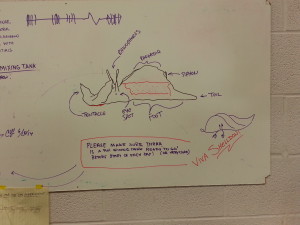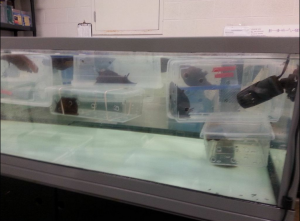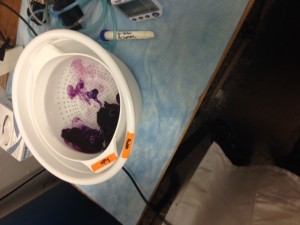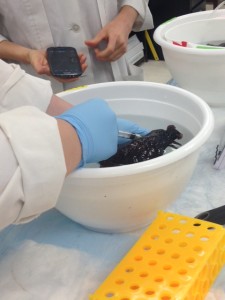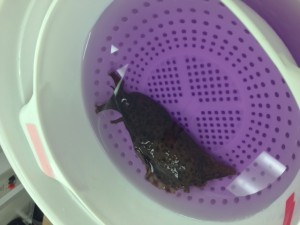The first thing the lab assistant from the neurobiology did was has us touch and learn the parts of the sea hare first hand. Cool and super soft to the touch, the snail was friendly enough to hold and was fun to try and keep him happy in your palm.
The lab assistant explained how they come from the cold waters of California. How they were called hares because of their two tentacles, but some people debated about calling them slugs or snails because they had a tiny shell inside of them from childhood which their body grew around. He explained how to touch the least sensitive side of the slug (along its side) because anywhere else could hurt or freak out the little guy.
It was interesting to learn about the different kinds of organs that the sea hare has. A lot of sea animals only have “eye spots” to tell light from darkness and use tentacles to tell where they are going. We learned how top flaps retreated in when the snail was provoked to protect their organs from predators.
One of the experiments that they did was shock the sea hare with .60 amps and try and see how the sea hare reacted to being shocked repeatedly. They kept track of the different kinds of reactions (already done for the experiment) or different types of conditions (pregnancy) by writing on the plastic boxes.
The sea hare would squirt purple ink in defence when shocked. It’s that color from what they eat and “tastes” really nice to crabs. Thus when they squirt out the ink, it floats away gently in the flow and the crap follows. However, sea hares are also poisonous to be eaten so are very durable.
Sea hares do a lot more experiments and one of those experiments require them to hum”recycled.” What makes the sea hare so special in research is the very small amount of neurons that it possesses. When a sea hare is thankfully lost in a coma, they are cut open alive.
The reason being is so all the neuron connections are still alive as well. This is important because the researchers still want to know the different reactions that a sea hare will make even when they are just cells inside of a computer.
Sounds like something straight from a scifi show, but it was amazing (in a kind of scary way) to see what science is capable of doing. Even after its body’s “death”, a sea hare is still “alive” enough to be poked and to make reactions for the researchers in the neurobiology lab.
I asked before we left what the purpose of all this was and if all there deaths of this amazing little guy was worth it and I got a pretty good answer. All these experiments are meant to help us learn about neurons, our own brains, and our own reactions to past pain experiences. PTSD is a real disorder that many people suffer from which hopefully (with the help from the little guy) won’t be a problem or too much longer.

